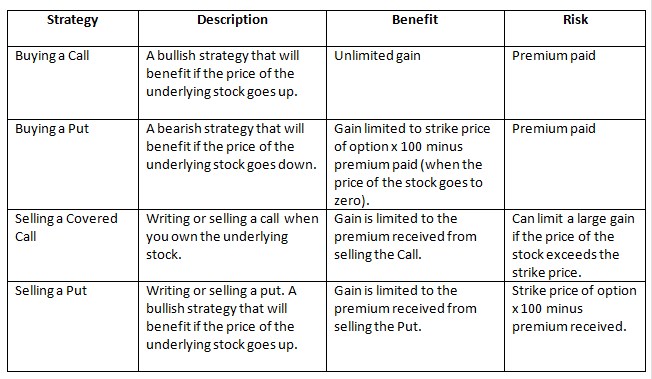
22 Dec Options are risky, right?
by Jeff Rossi, CFP®, Peak Wealth Advisors
Investing in stock options is not for everyone, and they do have inherent risk, but for the right investor with the right goals, options may be a viable strategy.
Let’s start out with a brief education on options.
A stock option is a security that is traded on a listed exchange. An option is a security that gives the owner the right to purchase or sell the underlying stock that it’s issued against at a specific price and by a specific date. You can buy an option and own a long position, or you can sell an option (without having a position in the underlying stock) and own a short position. The amount you pay when buying or receive when selling is called the premium.
The best way to understand how options work it is to look at some examples.
The table below illustrates three different securities, ABC Corp. (common stock), and two options, an ABC Corp. Call and an ABC Corp. Put. The “ABC Jan 2016 45 Call” gives the owner the right to buy ABC Corp. stock at the price of $45 per share (the strike price) any time before the Call expires in January. Most options will expire at the market close on the third Friday of the month. The “ABC Jan 2016 45 Put” gives the owner the right to sell ABC Corp. stock at the price of $45 per share.
If I wanted to purchase the right to buy ABC at $45, I would have to pay $600 plus commission. This is because each option gives you the right to control 100 shares of the underlying stock, so 100 shares multiplied by the price of $6 is $600. In our example, the Call is priced higher than the Put, which makes sense considering the price of the stock.
If I could buy the stock right now at $45 when it’s trading at $50, I’d immediately have $5 per share in profit.
The profit when looking at the price of the stock compared to the exercise price of the option is called the “intrinsic value.” If you’re following along with the math, you might be wondering why the intrinsic value is $5, but the cost of the Call is $6? That’s because there is still a lot of time left to exercise the option and for the stock to possibly rise in value. So the ABC Call has $1 of time value included in the price, too. Conversely, the Put has no intrinsic value since it wouldn’t make any sense to exercise it to sell at $45 when the stock is trading at $50, so we could surmise that the $1 for the Put is just time value. The time value will decrease as the option gets closer to its expiration date.
Benefits and Risks
The math described above points to some of the immediate benefits of options. Being able to control 100 shares of stock without having to plunk down $5,000 — as in our example — is one of the main benefits. If I bought the Call for $600, I’d control 100 shares of the underlying stock. If it goes up, so will my Call, and I could sell my call for a profit just like I could sell a stock. Or, I could exercise it and buy the 100 shares of ABC at $45. The profit margins for options generally work in your favor if everything goes right. If you purchased the “Jan 2016 45 Call” at $6, meaning you laid out $600, and the price of the stock went up to $51, the option would then have $6 worth of intrinsic value, plus whatever time value is left. For argument’s sake, let’s say the time value is $1, which would make the price of the Call $7 or $700. If you sold it, your profit would be $100 or a 16 percent return ($100 profit/$600 initial investment). If you just decided to buy 100 shares of the stock at $50 and sold it at $51, your profit would also be $100, which is just a 2 percent return ($100 profit/$5,000 initial investment).
Options are not without risks. Unlike a stock, which you can hold as long as you want, options expire. The closer an option gets to the expiration date, the lower the price will go due to the decrease in time value. So that $600 that you paid for our Call can be worth zero come the third Friday in January if the stock price is below the strike price of the option. In the riskiest strategies, options can have unlimited risk, meaning there’s no limit to what you can lose.
Enough of the fundamentals. Let’s talk strategy. There are many, many options strategies. Some are very complex and extremely risky. But let’s look at some of the simpler, more common strategies.
Buying a Call
As discussed above, options provide additional leverage because you can control a large amount of shares and invest less than if you purchased the stock outright. It’s also a way to reduce the amount you put at risk if you feel the stock is going to go up. So buying a Call can be a strategy to use if you’re bullish and don’t want to invest directly in the stock. In some cases, it does make sense. Buying 100 shares of Alphabet Inc. (Google) would cost you around $74,000 for 100 shares in mid-December 2015. Compare that to the February 740 Calls, which would cost you around $1,900. That’s a lot less money out-of-pocket if you feel strongly that the stock will appreciate significantly between now and the expiration two months from now in February. If you’re wrong, the most you can lose is $1,900.
Buying a Put
The same leverage concepts apply with purchasing a Put. However, the profitability of a Put is limited to the depth that a stock can sink, which is only zero. A Call has unlimited upside because it there is no cap to how high a stock can rise. So if you think a stock is going to decline between now and the expiration date of the option, you might want to purchase a Put. You might also want to purchase a Put if you own the underlying stock and you’re concerned it will decline. Owning a Put is a hedge, so if you want to protect against a loss, or you want to protect a gain, a Put will provide that protection.
Remember, owning a put gives you the right to sell 100 shares of the underlying stock at the strike price. Let’s say you bought 100 shares at 50, and now it’s 75. You have a $2,500 gain that you’d like to protect. If you think the stock has the possibility of declining substantially, you might buy a $75 Put that would give you the right to sell 100 shares of the stock at $75 until the option expires. If the premium was $5, your cost would be $500. At some point in the future if the stock dropped to $60, you could exercise your option and sell it for $75 a share, protecting your $25 per share profit (minus the $5 premium you paid).
Selling a Covered Call
A Covered Call really serves two purposes: to generate income and to lower the cost basis of stock that you own. If you purchase 100 shares of stock at $50, and sell a Covered Call that gives you $5 in premium, it’s as if you purchased the initial 100 shares of stock at $45. You can also generate income using covered calls. If you sell a Covered Call and it expires worthless because the stock price at expiration is below the strike price, you keep the premium that you received when you sold the Call. And you can keep selling Calls against that position for as long as you hold it. In a sideways market, meaning the stock price is relatively stable, it’s a strategy that can help create gains where there might not have been any.
But beware. Because a Covered Call is a short position, you have the obligation to sell the stock (as opposed to the right to buy if you were long) if the option owner were to exercise their Call — and they will if the price of the stock rises above option strike price. This serves as a means to potentially cap any gains that you might have earned had you not sold a Covered Call against your long stock position. Adding onto the example above, if that stock that you bought at $50 has a Covered Call with a strike price of $60 written against it, if the stock skyrockets to $100, you’d be forced to sell your shares at $60, leaving $40 per share in profit on the table (minus the $5 in premium that you received when you sold the Call).
Selling a Put
Selling a Put — which is referred to as being “naked” — is perhaps the riskiest and most speculative of the strategies outlined above. Because you’re selling, you have no rights, but you have an obligation to buy the stock at the strike price of the Put. In return, you receive a premium from selling the Put that you hope you can keep. You will be able to keep the premium if the price of the stock is above the strike price at expiration. Your best hope when selling a Put is to have the option expire worthless so you can keep the premium.
So why would someone sell a Put when the downside can be so much worse than the upside? Someone who is bullish on a stock and wouldn’t mind purchasing it for a price that’s less than the market price might sell it. For example, if a stock is trading at $60, a price you feel is too expensive, you might sell a $55 Put for a $6 premium. If the stock keeps going up from $60, your $55 Put will expire worthless and you’ll keep the $600 premium you collected. If it falls to $55 or below, the owner of the Put will exercise it and you will be obligated to buy it at the $55 strike price , and since you collected $6 in premium, your cost basis is effectively $49 a share. Of course if it falls to $10 a share, you still own it with a cost basis of $49.
When used properly, options allow you to gain better control over the risks and rewards of your portfolio depending on your forecast for your stocks. No matter if your forecast is bullish, bearish or neutral, there’s an option strategy that can be profitable if your outlook is correct.
That said, options trading is not something you should or could just decide to do. Definitely seek more education so that you’re clear on the risks you’ll be faced with, and talk to a financial professional who can help you decide if using options makes sense for your situation. The securities industry requires investors get approved by their broker to trade options, which is a safety valve so that only investors with an appropriate level of experience and resources are approved to use the more advanced and risky options strategies.
Jeff Rossi is a Certified Financial Planner with Peak Wealth Advisors in Holmdel. He may be reached at jeff@peakwealthadvisors.com or (732) 546-4790.
This story was first posted in December 2015.
This is a sponsored section. The advisors have paid a fee to post their commentary here. Their sponsorship doesn’t influence any editorial decisions we make at NJMoneyHelp.com, or give them more or less exposure in our stories. Their posting does not constitute an endorsement by NJMoneyHelp.com.



